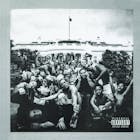Kendrick Lamar has always been an artist who moves with absolute intention. Since his debut commercial mixtape Section. 80, the unparalleled Compton wordsmith has made a habit of constructing lyrically and thematically dense concept albums with the intention of telling stories of the Black American experience through his eyes. And his major-label debut, good kid, m.A.A.d city, is just that and so much more.
good kid, m.A.A.d city is billed as “a short film by Kendrick Lamar,” and the project is comparable to coming-of-age film classics like Stand By Me, The Wood, and Boyz n The Hood, with its structured pacing of three acts and a clear beginning, middle, and end. A memoir chronicling a 16-year-old Lamar, getting into trouble on a 2005 Compton summer day, good kid... is the perfect introduction to the West Coast emcee’s ethos.
“A lot of these motherfuckers are good kids. That’s why I like to call Compton kids 'good kids in a mad city,' the influences are making them fucked up,” Lamar explained in an interview with Complex. “Everything is premeditated. What I think happened is me visualizing that for so long, throwing that in the universe, it finally comes into play.”
The album is the emcee's case study on how the effects of gang culture, street violence, and drug abuse affect, not only himself, but all of the people around him. From start to finish, Lamar speaks through the highly impressionable, horny, curious, violent, and defiant adolescent version of himself, introducing mainstream Hip-Hop fans to K. Dot.
The album begins with the hypnotizing intro track “Sherane a.k.a Master Splinters Daughter,” introducing a sex-hungry Lamar, on the prowl to hook up with the neighborhood “hood rat” who his mother advised him to stay away from while he’s out borrowing her Dodge Caravan. Still wet behind the ears, young K. Dot tends to ignore the voice of reason, visiting a girl in a rival hood, stealing his mother's van, and apparently ignoring her calls; the track sets the tone for the shenanigans that commence later in the album. Lamar continues to portray his adolescent self as living in a very “ignorance is bliss” state of mind on the track “Backseat Freestyle,” where K. Dot freestyles in the back of his friend’s car, further expressing his thirst for money, power, respect. The song’s music video shows Kendrick Lamar on tour in Paris when his father calls asking to return his mother’s car and his dominos, portraying he’s still a victim of this worldly mind state.
“I wrote that song from the perspective of being 16 years old,” Kendrick explains in an interview. “I knew who Martin Luther King was then but didn't know how much of an impact he made. We know what dream Martin Luther King stood for, but being 16, the dream we stood for was money, power, sex, drugs, murder, and things like that, so that was the perspective I had as a 16-year-old kid.”









